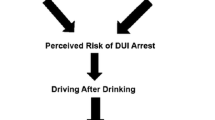Abstract
The research and practitioner literature has generally established that frequent, well-publicized sobriety checkpoint programs produce reductions in drunk driving and related social ills through increasing the perceived risk of apprehension in the general population. As such, the accepted measure of whether a checkpoint program ‘works’ is general deterrence. However, infrequent sobriety checkpoint programs do not produce general deterrence and there is no established alternative for defining the effectiveness of such programs. Given that infrequent checkpoint programs are a fiscal reality in many locations, we argue for a simple specific deterrence metric for monitoring the impact of such programs. Specifically we compare the mean number of Driving Under the Influence arrests on checkpoint days versus non-checkpoint days. We use data from a police department in the Upper Midwest to demonstrate the practical use of such a metric and discuss the implications for maintaining such programs or shifting resources towards saturation patrols.


Similar content being viewed by others
References
Beck, K. and Moser, M. (2004) Exposure to the sobriety ‘checkpoint strikeforce’ campaign in Maryland: Impact on driver perceptions of vulnerability and behavior. Traffic Injury Prevention 5 (2): 101–106.
Campbell, D. and Stanley, J. (1963) Experimental and Quasi-experimental Designs for Research. Chicago, IL: Rand McNally.
Crank, J. (2003) Institutional theory of police: A review of the state of the art. Policing: An International Journal of Police Strategies and Management 26 (2): 186–207.
Elder, R., Shults, R., Sleet, D., Nichols, J., Zaza, S. and Thompson, R. (2002) Effectiveness of sobriety checkpoints for reducing alcohol-involved crashes. Traffic Injury Prevention 3 (4): 266–274.
Epperlein, T. (1985) The Use of Sobriety Checkpoints as a Deterrent: An Impact Assessment. Phoenix, AZ: Arizona Department of Public Safety.
Erke, A., Goldenbeld, C. and Vaa, T. (2009) The effects of drink-driving checkpoints on crashes: A meta-analysis. Accident Analysis and Prevention 41 (5): 914–923.
Fell, J., Lacey, J. and Voas, R. (2004) Sobriety checkpoints: Evidence of effectiveness is strong, but use is limited. Traffic Injury Prevention 5 (3): 220–227.
Ferguson, S. (2000) Comments on identification of alcohol involvement in initial interview. Transportation Research E-Circular, E-C-020 E11-E12. Retrieved 17 December 2012 from http://gulliver.trb.org/publications/circulars/ec020.pdf.
Ferguson, S., Wells, J. and Lund, A. (1995) The role of passive alcohol sensors in detecting alcohol-impaired drivers at sobriety checkpoints. Alcohol, Drugs, and Driving 11 (1): 23–30.
Greene, J. (2003) Battling DUI: A comparative analysis of checkpoints and saturation patrols. FBI Law Enforcement Bulletin 72 (1): 1–9.
Heeren, T., Smith, R., Morelock, S. and Hingson, R. (1985) Surrogate measures of alcohol involvement in fatal crashes: Are conventional indicators adequate? Journal of Safety Research 16 (3): 127–134.
Homel, R. (1990) Random breath testing and random stopping programs in Australia. In: R. Wilson and R. Mann (eds) Drinking and Driving: Advances in Research and Prevention. New York: Guilford Press, pp. 159–202.
Jones, I. and Lund, A. (1985) Detection of alcohol-impaired drivers using passive alcohol sensor. Journal of Police Science and Administration 14 (2): 153–160.
Lacey, J., Ferguson, S., Kelley-Baker, T. and Rider, R. (2006) Low-manpower checkpoints: Can they provide effective DUI enforcement in small communities? Traffic Injury Prevention 7 (3): 213–218.
Lacey, J., Jones, R. and Smith, R. (1999) Evaluations of Checkpoint Tennessee: Tennessee’s Statewide Sobriety Checkpoint Program. US Department of Transportation, Washington DC. Report DOT HS 808 841 for National Highway Traffic Safety Administration.
Levy, D., Asch, P. and Shea, D. (1990) An assessment of county programs to reduce driving while intoxicated. Health Education Research 5 (2): 247–255.
Levy, D., Shea, D. and Asch, P. (1989) Traffic safety effects of sobriety checkpoints and other local DWI programs in New Jersey. American Journal of Public Health 79 (3): 291–293.
Mastrofski, S. and Uchida, C. (1996) Transforming the police. In: B. Hancock and P. Sharp (eds.) Public Policy: Crime and Criminal Justice. Upper Saddle River, NJ: Prentice Hall, pp. 196–219.
National Highway Traffic Safety Administration. (1987) Sobriety Checkpoints for DWI Enforcement: A Review of Current Research. Washington DC: Department of Transportation.
National Highway Traffic Safety Administration. (2010) Traffic Safety Facts: A Brief Statistical Summary. Washington DC: Department of Transportation, National Center for Statistics and Analysis.
Pawson, R. (2006) Evidence Based Policy: A Realist Perspective. London: Sage.
Pawson, R. and Tilley, N. (1997) Realistic Evaluation. London: Sage.
Peek-Asa, C. (1999) The effect of random alcohol screening in reducing motor vehicle crash injuries. American Journal of Preventive Medicine 16: 57–67.
Richmond Times Dispatch. (2007) DUI checkpoints praised as deterrent but don’t yield the most arrests in Va., 17 June.
Ross, H. (1994) Sobriety checkpoints, American style. Journal of Criminal Justice 22 (5): 437–444.
Shults, R. et al (2001) Reviews of evidence regarding interventions to reduce alcohol-impaired driving. American Journal of Preventive Medicine 21 (4S): 66–88.
Stuster, J. and Blowers, P. (1995) Experimental Evaluation of Sobriety Checkpoint Programs. US Department of Transportation, Washington DC. Report DOT HS 808 287 for National Highway Safety Traffic Administration.
Voas, R. (2008) A new look at NHTSA’s evaluation of the 1984 Charlottesville sobriety checkpoint program: Implications for current checkpoint issues. Traffic Injury Prevention 9 (1): 22–30.
Voas, R., Rhodenizer, E. and Lynn, C. (1985) Evaluation of Charlottesville Checkpoint Operations: Final Report. Washington DC: National Traffic Safety Administration. Technical report.
Wells, J., Preusser, D. and Williams, A. (1992) Enforcing alcohol-impaired driving and seat belt use laws, Binghamton, NY. Journal of Safety Research 23 (2): 63–71.
Author information
Authors and Affiliations
Rights and permissions
About this article
Cite this article
Browning, S., Thompson, K. Specific deterrence and the infrequent use of sobriety checkpoints. Secur J 29, 340–351 (2016). https://doi.org/10.1057/sj.2013.31
Published:
Issue Date:
DOI: https://doi.org/10.1057/sj.2013.31




